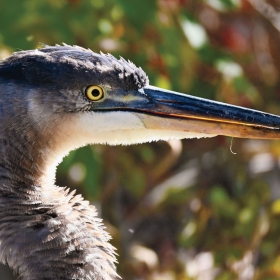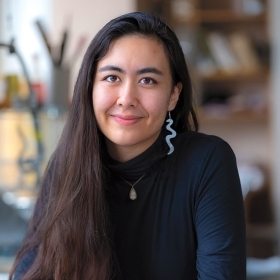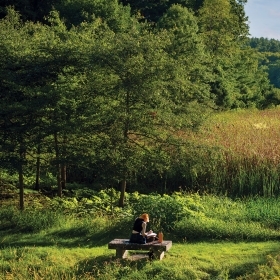Reports from Around Campus
A great blue heron named George, Picturing Pompeii at the Davis, and the class of ’21 outcomes

Photo by Akanksha Basil ’25
Of a Feather
Akanksha Basil ’25 created the Instagram account @birdsofwellesley to share her photography in a way that would generate greater awareness of the ecosystems (and creatures) around campus. “There’s one great blue heron around here who spent this winter on Wellesley’s campus—I call him/her George. I love seeing George around here—it’s so interesting watching him/her stalking chipmunks around our wetlands like a little dinosaur,” Basil says. She took this portrait of George on a particularly warm day last November, sitting quietly beside the bird for a long time. “This moment was particularly stunning—George fluffed up his/her feathers for just a second, during which the sunlight illuminated his/her figure and accentuated the facial details. It made all the waiting worth it,” Basil says.
Tourist Snaps
The Davis Museum exhibition Picturing Pompeii: Archaeology and Early Travel Photography uses photographs and objects from the museum’s collection to explore how photography in the late 19th century played an important role in Italy’s developing tourist industry and helped shape the public’s perception of the ruins. The pre-assembled photo album pictured below includes 56 photographs of Pompeii. “What’s fascinating about this is you start to see the codification or standardization of images from Pompeii,” said Nicole Berlin, assistant curator of collections at the Davis, in a virtual panel in February. (See a recording of the talk at bit.ly/PastRuins.) Beginning March 8, the Davis Museum re-opened to all visitors, requiring masks and proof of vaccination, in compliance with Wellesley College policy.
“When Ukrainians are arming themselves with Molotov cocktails to defend their homes and families in every Ukrainian city, we, international students from Ukraine, must use our voices to contribute to the fight for freedom and encourage others to join us in this fight.”
Percent who accepted a job in STEM or health care, the most popular industries
Fellowship winners
Percent who were employed, accepted to graduate school, participating in a service/volunteer program, or serving in the military within six months of graduation
Percent who are attending graduate school
Percent who describe their outcome as an opportunity to engage in meaningful work


